
This expert guide to keeping dogs safe in hot weather was written by veterinarians, Dr. Phil Zeltzman, DVM, DACVS, CVJ; Dr. Debora Lichtenberg, VMD; and Dr. Pippa Elliott, BVMS, MRCVS. Canine behaviorist/trainer Clarissa Fallis also contributed, as did writer Melissa Smith. This article was last reviewed and updated on May 16, 2024
If you have questions or concerns, call your vet, who is best equipped to ensure the health and well-being of your pet. This article is for informational purposes only and is not a substitute for professional medical advice, diagnosis, or treatment. See additional information.

- Understanding How Hot is Too Hot for Dogs
- What Temperature is Too Hot for Dogs?
- Common Summer Hazards for Dogs
- How to Prevent Heatstroke in Dogs
- Precautions When Swimming With Your Dog
- Dangers Your Dog Should Avoid at the Beach
- What You Should Know About “Summer Shaves”
Understanding How Hot is Too Hot for Dogs
Hot weather can pose significant risks to dogs, and understanding how hot is too hot for dogs is crucial for their safety. Our expert guide provides essential information on temperature thresholds, heat tolerance factors, and practical tips to keep your dog safe. Before diving into specific summer dangers, it’s important to recognize the signs of overheating and how to prevent heat-related illnesses. By following this comprehensive guide, you can ensure your dog enjoys a safe and enjoyable summer.
What Temperature is Too Hot for Dogs?
How Hot is Too Hot for Dogs Outside?
When it comes to outdoor temperatures, anything above 85°F (29°C) can be risky for dogs, especially if they are not acclimated to the heat. Dogs can overheat quickly, leading to heat exhaustion or heatstroke. To determine how hot is too hot for dogs outside, monitor the temperature and limit outdoor activities during peak heat times. Always provide shade, fresh water, and frequent breaks to keep your dog safe in hot weather.
How Hot is Too Hot for Dogs to Walk?
Walking your dog in temperatures above 80°F (27°C) can be dangerous, especially on humid days. Hot pavement can burn your dog’s paws, and the heat can cause them to overheat rapidly. Understanding how hot is too hot for dogs to walk is crucial; aim for early morning or late evening walks when the temperatures are cooler. Test the pavement with your hand; if it’s too hot for you to touch comfortably for more than a few seconds, it’s too hot for your dog’s paws.
How Hot is Too Hot for Dogs in a Car?
Temperatures inside a parked car can rise rapidly, even on mild days. When it’s 70°F (21°C) outside, the temperature inside a car can reach 100°F (38°C) within 20 minutes. This can be fatal for dogs, leading to heatstroke in a matter of minutes. Knowing how hot is too hot for dogs in a car is vital; never leave your dog in a parked car, even with the windows cracked. If you must travel with your dog, keep the air conditioning on and ensure they have access to water.
How Hot is Too Hot for Dogs’ Paws?
Hot pavement and asphalt can cause burns and discomfort to your dog’s paws. A good rule of thumb is the “seven-second test”: if you can’t hold the back of your hand on the pavement for seven seconds, it’s too hot for your dog’s paws. To understand how hot is too hot for dogs’ paws, remember that temperatures as low as 85°F (29°C) can be enough to cause burns, especially on dark or unshaded surfaces. Protect your dog’s paws with booties or by walking them on grass or shaded paths.
Common Summer Hazards for Dogs
Antifreeze/Radiator Coolant
When temperatures rise in the summer, cars (whether it’s yours or not) can leak antifreeze.
Or people may have spilled some liquid while topping it off. The green fluid contains ethylene glycol, and its sweet taste is appealing to both dogs and cats. It is extremely toxic (that is, deadly), even in very small amounts.
Take your dog (cats are usually smarter) to the veterinarian immediately if you suspect they licked some antifreeze.
A safe alternative to ethylene glycol antifreeze is available: propylene glycol. Many people wish ethylene glycol will be banned and propylene glycol will become mandatory.
Please note that antifreeze/coolant is a year-round danger.
Maggots (Yes, Maggots)
You may want to skip this one, as we are going to talk about maggots.
These critters can make even the most seasoned vet techs run for the break room. Our personal worst nightmare maggot cases have involved outdoor bunnies and sedentary longhaired dogs. Collies top the list.
The recipe for maggot infestation is simple:
- Mix some very hot weather with a sleeping or quiet animal.
- Add a little dirty fur and some fly poop.
- Let simmer for 1–2 days under the fur.
- Voila — you have a moving maggot feast.
Flies can lay eggs on bodily fluids or in diseased tissues: a wound, diarrhea, urine, eye drainage, pus, etc., and this is more likely in pets with a thick or long hair coat, or who live outside.
Prevention includes grooming, bathing, treating diarrhea and infections quickly, keeping pets indoors, and fly-control programs.
Flies lay eggs, which become larvae — that is, maggots — in as little as 12 hours. Maggots feed on animal flesh. They eventually become flies and are soon ready to lay eggs on the next victim.
Any animal can get maggots. Here are a couple of quick prevention tips:
- Keep thick-coated dogs trimmed in summer, particularly where some feces or urine might remain.
- Try to be vigilant about inspecting all body areas if your pet is exposed to flies and hot weather.
- A little bit of poop on your dog’s butt fur is unappealing at any time — but in a heat wave, it means fly strike.
Got pet rabbits? Keep outdoor rabbit hutches in the shade and step up your cleaning and inspection in hot weather. Check outdoor bunnies daily and pay special attention to their underside and private parts.
For more on this admittedly gross topic, see our article “Meet the Cuterebra — It Will Haunt Your Dreams.”
Barbecue Dangers
While fun for people, barbecues can cause many problems in pets:
- Lighter fluid is toxic to them.
- Trimmings can cause pancreatitis (inflammation of the pancreas).
- Bones are potential foreign bodies.
Also, a corn cob fed to a dog can get stuck in the small intestine. This is a serious and potentially deadly condition. The corn cob may stay in the dog’s gastrointestinal tract for days before we make a diagnosis — which often means that part of the intestine will need to be removed during surgery.
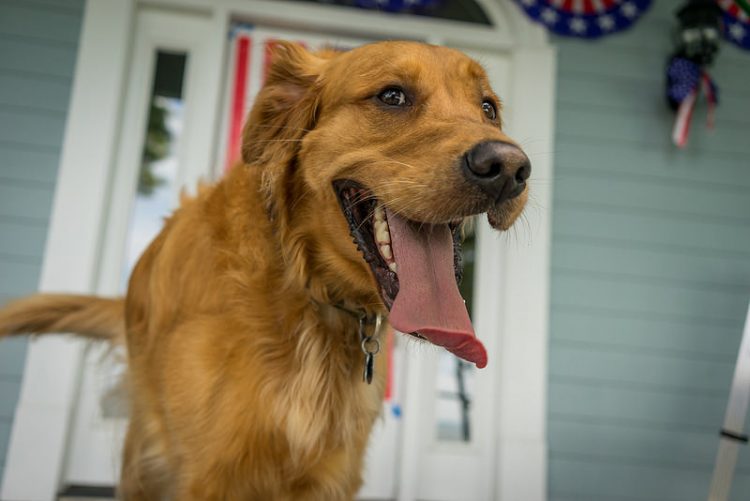
Diarrhea
Summer is a big season for acute bouts of short-lived diarrhea in otherwise healthy dogs. We often call this colitis or idiopathic colitis.
The typical scenario is you go to work in the morning, leaving your pooch happy and normal. You get home from work and when you open your door, you are greeted with the smell of 1,000 meat pies rotting.
When a dog has this type of diarrhea, the most common reasons are dietary indiscretion or stress, or both.
- Dietary indiscretion can mean your dog simply ate something they weren’t supposed to, or something new or different, or something that just didn’t agree with them. The summer season is a time for picnics, spoiled food and rancid trash. Yummy!
- Stress can mean a family vacation, excessive heat, visitors in the home, a stay in a kennel, a pet sitter. In short, any change in routine for your dog can be stressful.
Here are the hallmarks of this kind of diarrhea:
- Acute onset (diarrhea “out of the blue and on to the carpet”)
- Urgency, meaning the dog can’t wait to go outside
- Frequency, meaning you usually come home to many “piles” of poop throughout your home
- Straining, meaning your dog feels like they have to squat continuously, even when there’s nothing left, which leads to…
- Mucus and frank blood, signs that the colon is very inflamed
- Normal demeanor, meaning your dog seems healthy except for the diarrhea
How to Treat Diarrhea in a Dog
- Fast the dog (18–24 hours), even if your dog is hungry. You can offer as much water as you dog wants, as long as there is no vomiting.
- Begin a bland diet: boiled hamburger or chicken and white rice is a safe choice. Feed this in small amounts until the stool returns to normal.
- Once your dog’s stool has gone back to looking normal, gradually add small amounts of the normal diet, and watch the poop carefully. If the diarrhea returns, you may have simply weaned your dog off the bland diet too quickly. Start over.
- See the vet if your dog is acting ill, is vomiting, is anorexic or if the diarrhea is continuing. The list of serious conditions that can cause bad diarrhea is endless, and you need to seek medical attention in that event.
Bland Diet Recipe for Diarrhea in a Dog
Chicken and white rice is the doggy version of “a little chicken soup” for an upset tummy.
Was YOUR Pet Food Recalled?
Check Now: Blue Buffalo • Science Diet • Purina • Wellness • 4health • Canine Carry Outs • Friskies • Taste of the Wild • See 200+ more brands…

We like to recommend boiled chicken and white rice, two-thirds rice to one-third skinless, lean, cooked chicken. For vegetarians who hate cooking meat, you can substitute cottage cheese for the chicken.
Prescription diets are available if you don’t want to cook for your pet. Two popular examples:
- Hill’s makes I/D (intestinal diet)
- Purina makes EN (enteritis diet)
All these diets are low in fat and highly digestible, giving the GI system very little work to do so it can heal.
Final Thoughts on Dog Diarrhea in the Summer
- Make sure you’re giving a heartworm preventive with an anti-parasitic for intestinal worms, especially during the summer months.
- Keep the garbage tied up carefully and provide no access to compost piles — yours or your neighbor’s.
- Ask your relatives at the barbecue to refrain from including your pets in the festivities.
- Bring or specify your pet’s normal diet to the kennel, to the sitter, to your mom.
Water Safety
Even though most dogs are considered natural swimmers, they can get into trouble if they fall into a swimming pool or fall overboard from a boat. This is true especially if your dog gets hurt in the process, or has conditions such as obesity or heart disease.
On a boat, use a dog life preserver/jacket.
At the beach, rinse the salt off your dog with clear water after a bath in the ocean.
Most pool covers are not appropriate to prevent disasters. Pets can end up under the cover and suffocate or drown. If your pet falls into a pool, they may not be able to get out of it with high, vertical, slippery sides and an impractical ladder. Some companies make dog friendly pool ramps.
Various states and countries have different rules when it comes to swimming pools, such as requiring a locked gate.
Too Much Swimming
Dogs can actually get too much of a good thing when they swim for too long of a time.
Water dogs who jump off docks and retrieve sticks for hours on end can develop something we actually call “Lab tail,” also known as limber tail syndrome and many other names. Labs and hunting breeds that use their tails like rudders can suffer from a sore tail for days to follow.
Although limber tail is not always associated with swimming, too many hours or days at the lake is the classic presentation. Note that this can be associated with very cold water too.
We’ll cover much more on dog swimming safety later in this article.
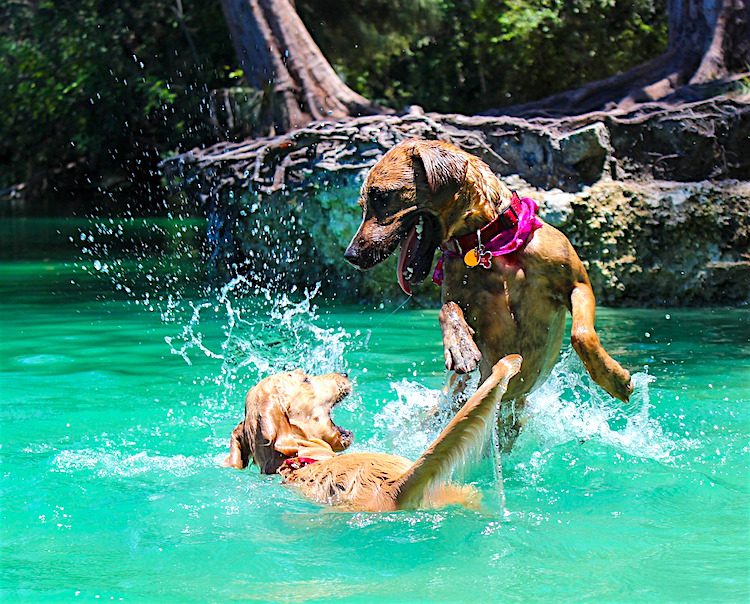
Car Windows
Car restraints will prevent your pet from jumping out of the window or bolting the minute a door opens.
We cringe every time we see a dog’s head sticking out of a car window:
- At best, the dog may get a severe case of conjunctivitis (eye inflammation).
- At worst, they may jump out the window and get road rash or skin lacerations, or wind up in the operating room with nasty fractures.
Don’t simply assume your pet has a special sense to avoid falling from a window. And don’t believe that just because your pet hasn’t done anything crazy 99 times, they won’t decide to jump the 100th time.
Hot Cars
Please don’t ever leave your pet unattended in a car, even with the window cracked open.
Some people are still misinformed and think their pet will be OK in a hot car for even a short period of time, or they can simply forget they left their pet in the car.
“Every year, hundreds of pets die from heat exhaustion because they are left in parked vehicles,” says the American Veterinary Medical Association (AVMA).
“We’ve heard the excuses: ‘Oh, it will just be a few minutes while I go into the store,’ or ‘But I cracked the windows…’ These excuses don’t amount to much if your pet becomes seriously ill or dies from being left in a vehicle,” says the AMVA, and quite rightly.
Here’s our best advice to avoid a hot-weather tragedy:
- Don’t bring your pet with you in the car on hot days.
- Don’t plan to just “stop in” to the drugstore or the post office with your pet in the car.
- Don’t think you’ll find a shady spot in a parking lot.
- Don’t think when you take your pet with you on a cool summer morning that it won’t be sweltering in a few hours.
- And please, please — don’t take your pet on your regular errands in the hot summer and forget they are in the car. You might run into a neighbor in Target and start talking or decide to go into a few more stores, forgetting you left your dog in the vehicle.
For more on this topic, see our article on keeping pets safe from hot cars, written by ASPCA president/CEO Matt Bershadker.
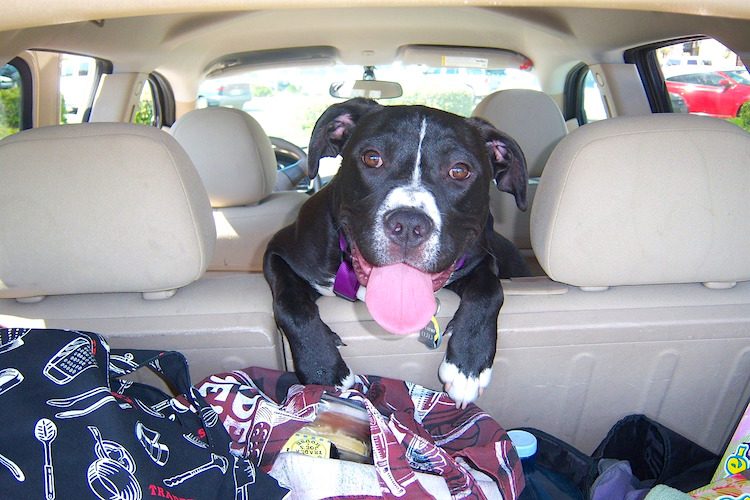
Hot Pavement
At least a few pets come in every summer with the pads burned off their feet.
Generally, burned pads occur only with enough time and a very hot sun.
Dogs can tolerate a quick walk on hot pavement, assuming people and dogs seek shady streets and areas in the boiling sun. However, any length of time walking or running on very hot surfaces can create painful lesions on footpads.
Don’t jeopardize your dog’s footpads in summer. Consider these variables:
- The substrate: Boiling city pavement or blacktop is more dangerous than dirt or grass.
- The length of time: How long has your pet been out running with you?
- The intensity: The worst pad lesions we’ve seen were on an intensely trained Border Collie who ran alongside his human (who was riding a dirt bike) for 4 hours midday in 90-degree sun. The man looked like a red lobster, and the dog’s feet looked like they had been dunked in scalding water. The wound care for this poor pup’s feet was costly, time-consuming and difficult.
If you live in a city and avoiding pavement isn’t an option, consider using a protective cover to protect your dog’s paw pads.
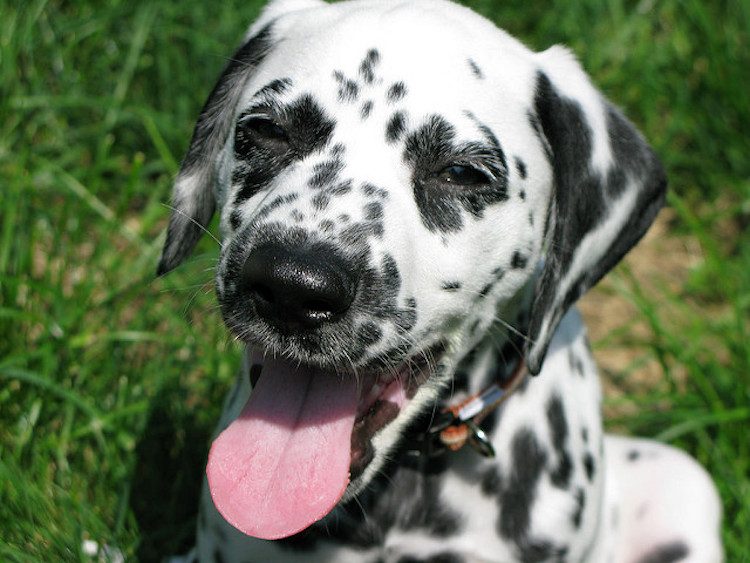
Sunburns
Does your dog have a pink nose or ears, or patches of white hair? If so, you need to know about the risk posed by sun damage.
Dogs don’t need sunscreen, you say! Their fur keeps them protected from the sun, right?
Although that may be partially true, there are times when you need to protect certain animals or certain areas on your pet’s body from the sun.
Certain dog breeds are prone to sun-induced diseases or conditions. They include:
- Dalmatians
- Weimaraners
- Greyhounds
- Chinese Cresteds
- Whippets
- Bulldogs
- Boxers
- Pit Bulls
- Staffordshire Bull Terriers
If your dog is short-coated, even places such as the trunk or legs that have fur are at risk. It’s all a matter of how long they spend outside and how fierce the sun is:
- Protect lightly-haired areas such as the abdomen, nose, eye area and ear tips.
- Protect white and lightly colored dogs from the sun.
Also, dogs or cats who have previously been diagnosed with conditions such as solar dermatitis, skin cancer such as squamous cell carcinoma or conditions like discoid lupus should be protected.
Which Sunscreen Should I Use for a Dog?
No human sunscreens are approved for use in dogs and cats, but most veterinary dermatologists recommend a baby-safe, spray-on sunscreen for pets at risk.
Sunscreens themselves are not irritating to the skin of dogs and cats. It’s the licking that’s the problem. As of now, Epi-Pet Sun Protector Spray is FDA-approved for dogs and horses, but not for cats. Ingredients in many sunscreens break down to salicylic acid (aspirin), which is toxic to cats.
Don’t use zinc oxide products either on animals — zinc is toxic if ingested.
How to Use a Dog-Safe Sunscreen
- Simply mist it all over the dog and then distract them with a toy while it dries.
- Reapply after swimming or every 4–6 hours, whichever is sooner.
The safety of many sunscreens is currently being debated. Some research claims they can do more harm than good. The problem is your pets don’t tolerate floppy hats and swim shirts very well.
If your pet is at risk, take that long walk early or late in the day. Avoid the blazing sun.
Signs of Sunburn in a Dog
Early sunburn is marked by reddened and inflamed skin that is tender to the touch.
This is often painful, which causes the dog to lick it. So if your dog’s skin suddenly seems irritated after spending time in the sun, be suspicious of sunburn.
A top tip for deciding if this is sunburn, parasites or an infection is to check the dog’s darker patches, if any exist. In spotty dogs such as Dalmatians, a telltale sign is a clear border of inflammation where the white furred skin stops looking sore where it meets the brown (protected) patches.
In the longer term, repeated sun exposure triggers other changes in the skin:
- Thickening
- Scarring
- Ulcers
- Crusts
- Spots
- Blackheads
Sadly, it’s only a hop, skip and a jump from here to cancerous change. Sun damage skin cancers are often erosive and ulcerative — which means they break open, weep and look incredibly sore and angry.
Take it from this vet — these summer hazards are no fun for your pet:
How to Prevent Heatstroke in Dogs
Heatstroke is a silent killer.
Every year, countless dogs, and some cats, die after being locked in cars while their folks run an errand, often for “just a few minutes.”
These tragic deaths are entirely preventable.
Heatstroke happens when your pet’s temperature becomes dangerously high, generally about 106 degrees Fahrenheit. It can be because of being locked in a hot car or exercising in hot and/or humid weather.
A chemical reaction breaks down the cells in your pet’s body.
Heavy panting, rapid pulse or heartbeat, bright or dark red gums and tongue progress to unconsciousness.
The end result is brain damage, organ failure and death.
What Happens to a Dog Who Has Heatstroke?
Remember how hot it can get inside your car on a summer day, even though it is not that hot outside?
That’s because a car acts like a greenhouse, trapping the sun’s heat.
“If it’s hot outside for you, it’s even hotter for your pet,” says the AVMA.
A Stanford University test found that:
- Even if it’s only 72 degrees outside (not very hot), a car’s internal temperature can rocket to 116 degrees within an hour.
- When it’s 85 degrees, the temperature inside the car increases to 102 degrees in 10 minutes, and 120 degrees in 20 minutes.
- Keeping the windows open barely helps.
What Is the Emergency Treatment for Heatstroke in a Pet?
- First, try to lower the temperature by moving your pet to a cool area.
- Soak your pet with cold water.
- Stop cooling measures when your pet reaches 103 degrees, or your pet may actually become too cold.
- Call the clinic ahead of time so that the staff can be prepared for your arrival (a good idea with any emergency).
- Take your pet to your family veterinarian or the emergency clinic as quickly as possible.
- At the vet, similar measures will be taken, in addition to IV fluids.
Will My Pet Survive a Heatstroke?
Survival depends on 3 things:
- Early detection
- Early and aggressive treatment
- Internal organ and brain damage
The largest study indicates a 50% survival rate.
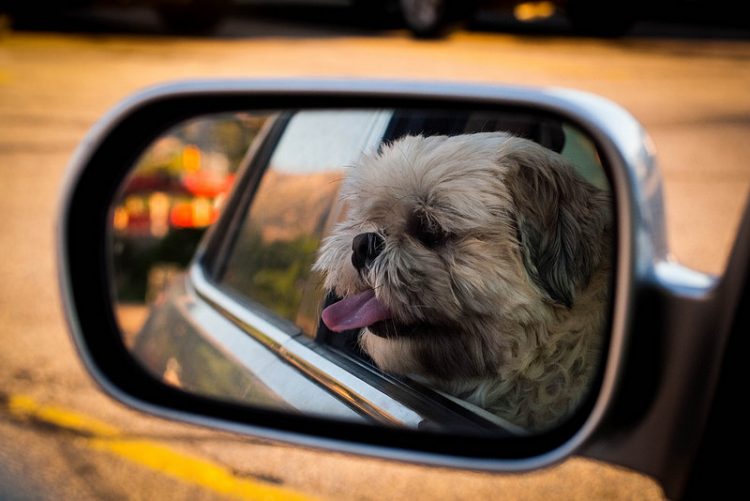
How to Prevent Heatstroke in Dogs
Here are some simple suggestions:
- On hot, humid days, keep your pets indoors, except to eliminate. Try to go out in the early morning and late evening.
- In particular, brachycephalic breeds or “squished nose” dogs like Pugs, Bulldogs and Pekingese should be in an air-conditioned house as much as possible. Outings should be limited to potty time and kept short. These dogs have a higher chance of respiratory distress in extreme weather.
- If they must be outside, provide plenty of shade and fresh water.
- Make sure your pet can’t spill the water source, or use several bowls in different places.
- Add ice cubes to the water bowl to keep water cooler longer.
- Plan ahead and make sure the shade will still be available as the sun changes.
- Never leave a pet unattended in a parked car, even for “just a minute.”
- Leaving the windows partially rolled down in the car won’t help.
- Carry water with you when walking your dog.
- Notice any heavy panting, loss of energy, weakness, stumbling or any of the signs listed above.
- If your pet seems to suffer from the heat, stop in a shaded area and give some fresh water.
- If things don’t improve quickly, don’t procrastinate — take your pet to the vet.
- Cool your pet down with a spray bottle or a garden hose.
- Let your pet play in a cool water “bath” or a children’s pool.
Heatstroke in dogs or cats is no joke. Don’t let it happen to your pet.
Ask your vet or a nurse to show you how to take your pet’s rectal temperature safely with a digital thermometer. And if you see a pet locked in a car, call your local animal authorities immediately — you may just save that pet’s life.
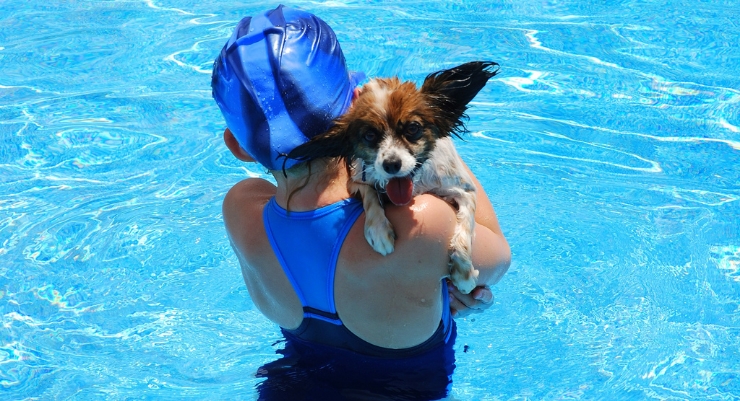
Precautions When Swimming With Your Dog
A common myth is that all dogs can swim.
Although most dogs like Golden Retrievers and Labradors can swim without much instruction, many others should be monitored while they are enjoying the water.
Dogs with short legs cannot move quickly enough to keep them afloat. For example:
- Basset Hounds
- French Bulldogs
- English Bulldogs
- Dachshunds
Dogs who have a low body fat percentage have a greater chance of sinking when they try to swim. For example:
- Greyhounds
- Boxers
- Dobermans
It’s important to remember that all dogs can drown.
In her book Woofing It Down, author Patricia O’Grady relates a personal (and scary) incident:
“Many years ago, one of my Yorkies accidentally fell into my swimming pool and almost drowned…. She treaded water as long as she could but couldn’t paddle fast enough to make up for the weight of all that wet hair. Just as she was sinking to the bottom, I was able to jump in and grab her … always supervise your dog swimming, you wouldn’t leave a small child alone in the pool; don’t leave your dog alone.”
Teach Your Dog to Swim
Not only should your dog should be able to swim before they go near a pool, but your dog should never be left unattended in or around a pool. That may sound insulting to your common sense, but awful stuff happens.
- Like children, the pool should be off-limits to your pets if you are not around.
- It’s easier to teach a dog to swim in a shallow area, like a lake or a pond, before introducing them to a deeper pool.
- If a dog can walk into water and swim or be gently placed in a few feet of water and swim to shore with a few doggy paddles, learning to swim is easier.
- If teaching your dog to swim in a pool, a doggy life vest is a consideration. See below.
- If your dog gets in trouble in a pool, rescuing them can be a danger to people. A medium to larger dog can take a human down easily when they are panicked in a pool. Best to never let this happen in the first place.
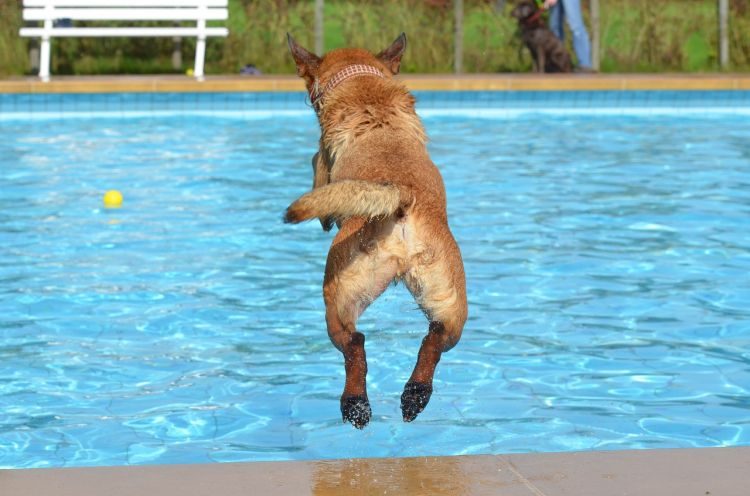
First, Your Dog Needs a Lifejacket
Our first suggestion with any dog is to get a dog life jacket. These come in a variety of sizes and colors that allow you to see your dog in the water.
Even if your pup is a competent swimmer, we highly suggest a lifejacket — especially if your dog is a boating companion.
First Time? Take It Easy.
If your dog isn’t naturally interested in the water and shows some hesitance, a bit of training will be needed to the dog acquainted with the water.
Don’t simply throw your dog in the water and hope those natural instincts take over — this is extremely dangerous.
- First, assess your dog’s apprehension toward the water at a shallow pool or a pond with a beach.
- If the dog seems comfortable standing in shallow water at the beach, slowly step out into the water and call your dog. It may help to have a favorite treat or toy to give them when the reach you.
- Slowly, you can go farther out into the water while requiring the dog to swim a little farther to get the reward.
- If your dog is uncomfortable and decides to turn back before they reach you, you’re going too fast and should go closer to shore.
The first outing into the water should be brief and positive. Your dog should be wearing a lifejacket in case they get too confident and decide to go out farther than they would typically be comfortable doing.
If your dog is still uncomfortable in the water and you’re determined for them to swim, consult a local trainer for help.
Your Dog Can Drown in Shallow Water
People may not realize that a dog can panic in a pool, even in shallow water or near pool steps.
- If a dog isn’t used to finding the pool steps or does not have easy access, they can panic and drown.
- Beware of standing water in pool covers and small dogs. Sadly, we’ve seen cases where toy breed dogs walked onto a covered pool laden with rainwater and drowned in less than a foot of water. Always be vigilant — tragedies do occur.
- Fencing and invisible fence products are great to keep your dog away from the pool when you are not watching. Nevertheless, don’t trust any artificial boundary: The pool fence door might be left open or your invisible fence might be turned off.
Bottom line: Keep dogs away from the pool unless you are with them.
Chlorine vs. Saltwater Pools
There are chemicals in all pools. The classic pool is chlorinated.
Saltwater pools, on the other hand, require fewer “chemicals,” but they still contain chlorine and other residue that should not stay on your dog’s coat or be ingested if they take a swim.
When a Dog Drinks Pool Water
Again, any pool has chemicals in the water, and the pool is not a good source of drinking water.
Common-sense pool tips:
- Don’t let your dog drink the pool water as a rule.
- A little pool water lapping may be inevitable and should not cause a problem.
- Some dogs with very sensitive stomachs may not be able to consume even a little pool water.
- Always supply clean, fresh water for dogs around the pool area.
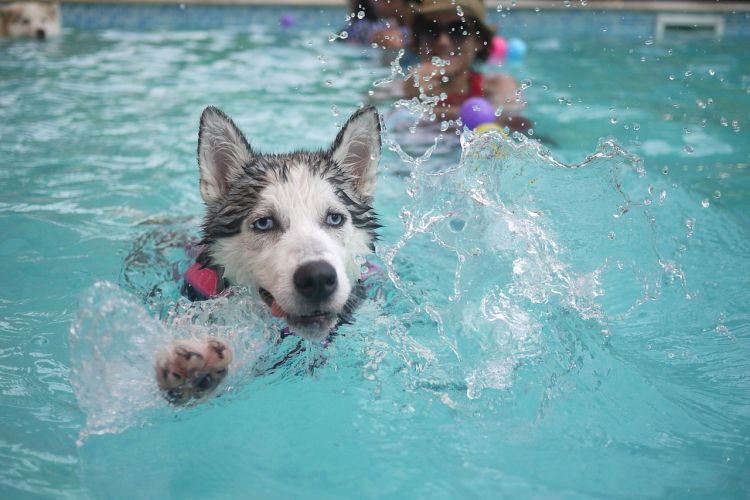
Safety of Pool Water for Dogs
No chlorine or saltwater residue is nice to have on your dog’s coat, particularly because Ms. Beach Beauty will lick herself once she’s done with her swim. Humans usually take a quick poolside shower instead of licking ourselves clean (right?).
If your dog immerses their beach bathing self in anything but fresh water, try to wash them off with a quick hose, shower or bath.
Think of your dog as having a huge head of hair after swimming:
- What do we do after a dip in the pool? We towel off and dry our hair.
- Your dog’s coat should be cleaned and not stay wet, and they need your help after a swim in the pool.
- Depending on the type of hair coat, towel-dry your dog and pay special attention to armpits, groin areas and places where continual dampness can cause skin irritations like dermatitis.
Dog Hair
Humans shed, but not in the same way our fluffy canine friends do.
For pool cleanliness, here are some hints to keep the dog hair contamination to a minimum:
- If this is a “planned” swim, take a comb to your dog and remove excess hair before their dip.
- An average-sized dog equals 3 humans+ in a pool. (The + symbol stands for some fecal matter on the coat, some insects and more dirt, debris, oils and fur than the average human. No matter how you cut it, your dog is usually dirtier than you.)
- Your skimmer baskets are usually not good enough to trap all dog hair.
- More residue from your dog can mess up all those things that drive you crazy about pool cleanliness.
Bottom line: Your dog in the pool makes it harder to keep your pool clean.
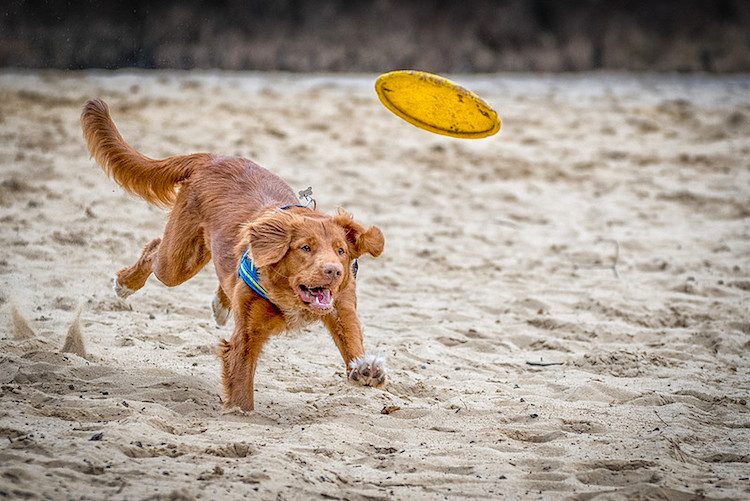
Dangers Your Dog Should Avoid at the Beach
Here are a few of the hazards that can befall the unsuspecting pup at the beach.
Saltwater
It’s a blisteringly hot summer’s day, and your dog is overheated. The perfect solution is a plunge in the ocean. But be careful.
The dog who swims or plays catch in the surf can swallow a significant amount of seawater.
This salty water contains high levels of sodium chloride, an electrolyte that destroys the delicate salt balance in body tissue.
The immediate effects include vomiting.
In some cases, sodium still makes it into the bloodstream and draws water into the delicate tissue of the brain. The results are:
- Rigid muscles
- Seizures
- Kidney failure
- Coma and death
So what do you do if you suspect your dog has drunk seawater?
Here are 2 biggies:
- Offer fresh water to drink, little and often
- Get to a vet, even if the dog seems fine.
Typically, the neurological signs don’t develop for a couple of hours. The risk is you think you’ve gotten away with it, but the dog becomes severely ill a while later. Only prompt, early treatment by the vet can prevent this.
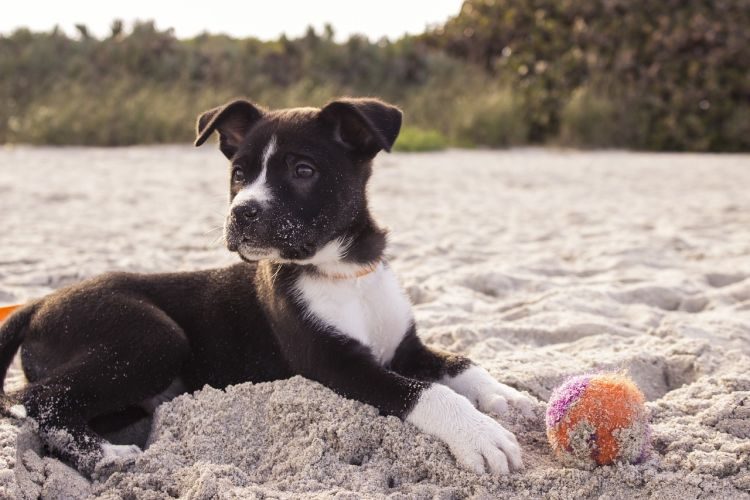
Palm Oil Pollution
Palm oil is used in the manufacture of foodstuffs.
It can legally be dumped at sea by ships, where it enters the ocean and gets washed up on beaches.
Imagine a Labrador Retriever bouncing across an unexpected harvest of fatty white stuff and they’re going to scarf it down. Unfortunately, this edible sea bounty is anything but harmless because it makes dogs ill.
Small quantities of pure palm oil are likely to make the dog vomit and have diarrhea. Some cases lead to severe dehydration, requiring intravenous fluids to restore dogs to health.
But the hazards don’t end there.
Palm oil is a solid fat, and as such it’s like touching a lighted match to a fuse for those dogs who are prone to pancreatitis. Scavenging some palm oil could trigger a serious bout of illness, requiring hospitalization.
And there’s still more…
The solid lumps of palm oil can stick together inside the gut and cause a blockage. These dogs vomit and can’t keep food down. Prompt diagnosis and surgery is essential if they are to recover.
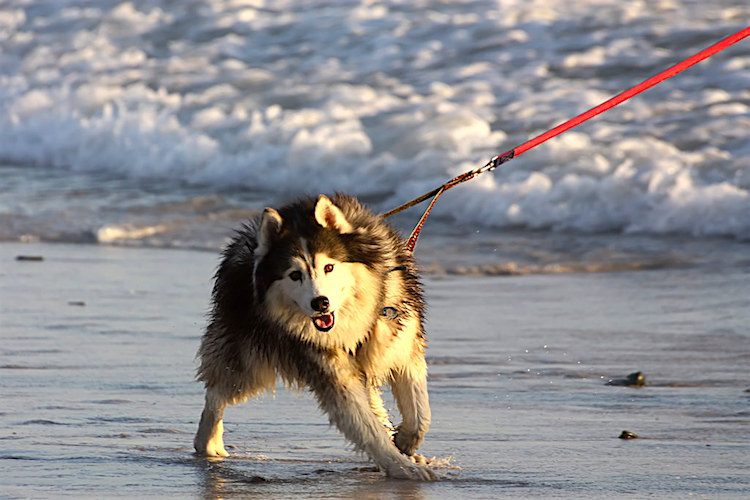
Jellyfish
Certain common species of jellyfish can still sting, even weeks after their death.
It only takes a curious dog, using their nose to nudge a washed-up jellyfish, and they could get significant stings.
With dogs, the areas most at risk are the nose and mouth (for obvious reasons), paws and areas with little fur to protect them.
Signs of jellyfish stings in a dog include:
- Vomiting
- Diarrhea
- Swelling
- Drooling saliva
- An irritated mouth
- Pain and distress
- Raised body temperature
- Muscular twitches
- Breathing difficulties
In non-tropical areas, if your dog has been stung, carefully wash the area repeatedly with seawater (or drinking water for the mouth). Where possible, remove the stings, but avoid rubbing the area — and be especially careful not to rub sand into the skin.
In tropical areas, rinse the area with vinegar, although the chances of having vinegar on the beach are slim. Other treatments include antihistamines and pain relief. Sometimes steroids are necessary to stop the swelling.
Plants
You might be thinking, “No big deal — instead of the beach, we’ll go to the pond.”
Well, watch out for blue-green algae then.
This hardy algae grows in fresh and brackish water ponds and lakes. You can detect it by its blue-green coloring as it drifts across the surface of the water. This algae is toxic and can cause severe illness or even death in your pets.
“Blue-green algae can produce two types of toxins, microcystins and anatoxins. The clinical signs of poisoning depend on which toxin is involved,” warns VCA Animal Hospital.
“Microcytins can severely damage the liver causing organ failure,” VCA adds. “With anatoxin exposure, death is quick, often within minutes to hours post-exposure.”
The best way to avoid this algae is to remain alert when approaching any pond, lake or other form of standing water, particularly in the summer and fall.
Rip Currents
Many dog breeds are excellent swimmers and are, in fact, bred to be water dogs.
But make no mistake, in a rip current — a powerful current of fast-moving water — they’ll be as helpless as a 10-pound Pug.
Most of you know that you can swim with the current and eventually get ourselves back to shore. But your dog won’t understand that and can be quickly swept away.
Rip currents and riptides tend to be more active during stormy weather, but they can happen at any time, so be vigilant when you bring your dog with you to the beach.
Be Prepared When Your Dog Is With You at the Beach
Be sensible, and your dog will have a whale of a time on the beach.
Be cautious about heat — both on the paws and also from overheating. And don’t forget the 5-second rule: If the sand is too hot to hold your hand on the ground for 5 seconds, then it’s too hot for your dog to stand on.
In the video below, take a dog’s-eye view of a dip in the sea:
What You Should Know About “Summer Shaves”
Hamlet may not have had pets. But even if he did, he might ponder the notion of pets’ well-being with a fantastic soliloquy:
“To shave or not to shave? That is the question.”
And, actually, it’s a big question.
If you want to do a cautious clip-down or shave, the goal is a happy pet with a coat that is easier to maintain. Trimming your pet’s sand-, sea- or mud-ridden coat is one thing, but shaving just because it’s hot out is quite another.
In any case, it’s important to stay on top of the stuff that can cause your pup irritation, but here are some thoughts:
Coats Naturally Keep Pets Cool in the Summer
Lots of people want to “shave their dog down for summer.”
We’re talking Golden Retrievers or even sometimes Northern breeds that don’t usually get clipped, coifed and blow-dried like a Standard Poodle.
But most veterinary dermatologists and experts advise against shaving your dog or cat down for the intense heat of summer months.
The overriding theory is that pets’ coats are designed to keep them cool in the summer and warm in the winter. This is not a theory, in our opinion — it’s a fact.
A moderate clip or shave on your dog or longhaired cat in the summer months can help you attend to the coat. Hygiene is truly the only reason you should shave your pet.
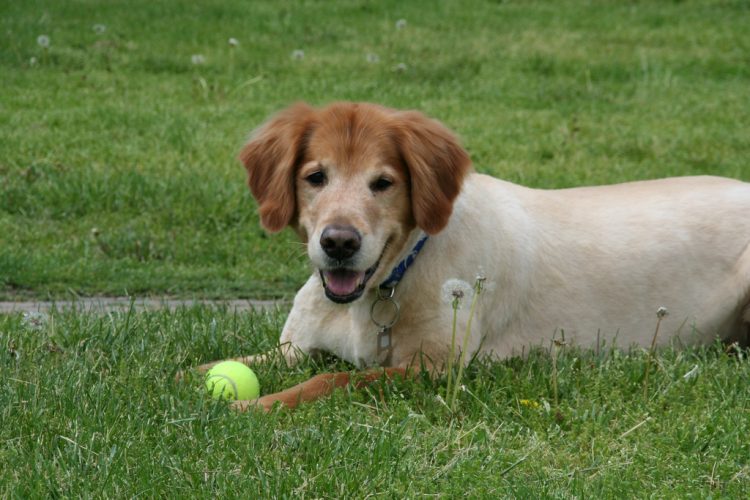
Tell Your Groomer: Leave at Least 1 Inch
This is a major pet peeve (pardon the pun), as we have seen dogs and cats shaved down a little too close for comfort by clipper-happy groomers.
It is easy for a groomer to put on that major grooming blade and shave your pet down to their skin.
Don’t let them do this — tell them they need to leave at least 1 inch of fur before they start. If the groomer says the dog is too matted, ask more questions. It is rare that dogs are so badly matted that they need a surgical clip.
Leave 1 inch of hair, fur, whatever you want to call it, but don’t let a groomer denude your dog or cat.
Your pets need that fur. They are not hipsters — they will not benefit from a shaved head with a little beard. And they cannot buy a hat to shield them from the elements.
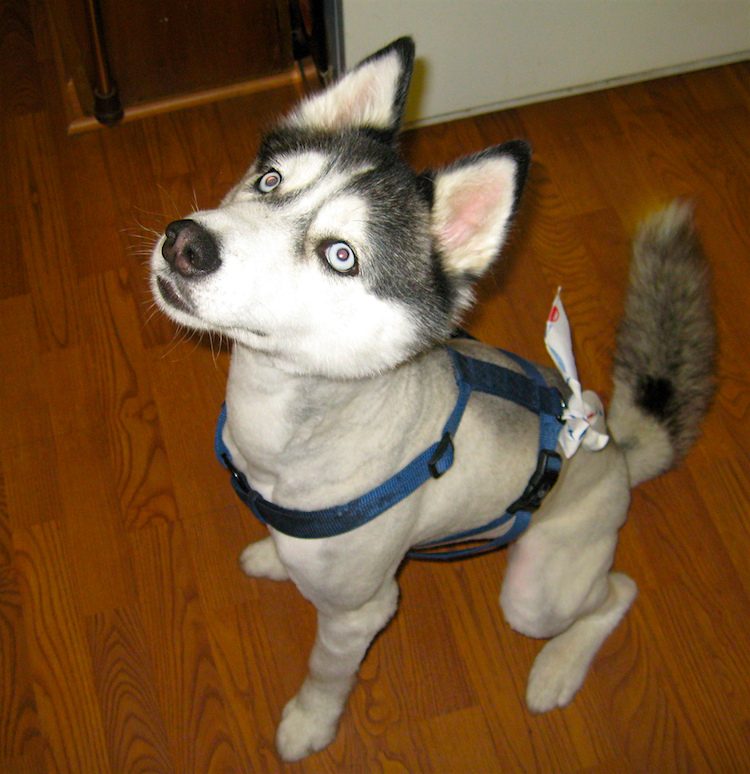
3 Things That Happen When You Shave Too Close
Our pets were built with an in-house layer of sun and winter protection, otherwise known as their coat.
When we mess with it, we have to be responsible for the consequences.
If your pet’s coat is cut down too close to the skin, here are a few things that may occur:
1. Pets can get a sunburn.
Yes, again, this happens. When we see any animal shaved down to the skin, particularly light-skinned dogs like Goldens, Labs, Huskies or Samoyeds, they better watch it in the sun.
They were born with a coat of protection, and we need to respect it.
2. Northern breeds’ coats may grow in poorly.
Watch those Northern breeds. These include Huskies, Samoyeds, Alaskan Malamutes and Norwegian Elkhounds.
These dogs are not supposed to lose their coats, which often grow in poorly if shaved. It is never recommended to shave these breeds.
3. Pets may (or may not) feel shame over their lack of fur.
You may laugh, but let us tell you, many pets get upset with the clip-down.
They act vulnerable. They don’t know what happened to themselves, particularly if the groomer cut them down too close to the skin.
Other dogs love the free feeling and relish this lack of fur.
Just don’t let your groomer get crazy with the clippers — always talk about your pet’s needs first.
This video explains more:
Final Thoughts on Keeping Dogs Safe in Hot Weather
Hot weather can mean great time outdoors and fun activities. But it can also tucker us humans out.
If you are hot, sweaty and tired, think of how that heat is affecting your pets. Being vigilant will prevent any of these summer mishaps from happening.
Most summer veterinary emergencies can be avoided or certainly kept to a minimum with good old common sense.





